Being proactive is a good thing in the fall rose garden. Many diseases can be stopped in the fall. Cleaning up your rose garden in the fall makes it harder for them to return in the spring.
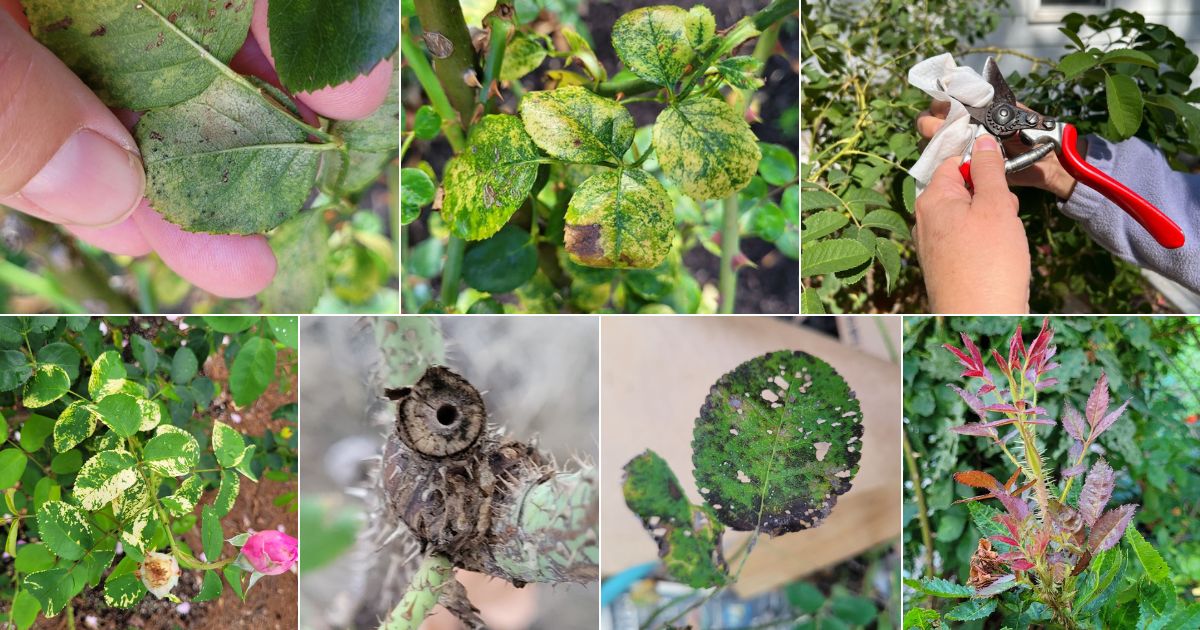
This also decreases the amount of work you have to do in the busy, busy spring season and makes it easier to keep disease and pests down as you roll into summer. Some of these suggestions will also make your life easier through summer and into fall.
Here are ways to clean up the diseased parts of your roses to make it harder for these diseases to return next year.
Jump to:
- What You’ll Need
- Tips to Stop Diseases and Pests in The Fall Rose Garden
- 1. Get Rid of Diseased Leaves
- 2. Keep Infected Material Out of the Compost and Soil
- 3. Practice Good Sanitation
- 4. Horticultural Oil Smothers Pest Eggs and Fungal Spores
- 5. Use Systemic Disease Granules to Stop Fungal Diseases
- 6. Build Up the Soil Around Your Roses for Increased Pest and Disease Resistance
- Diseases to Look Out For in The Fall Rose Garden
- Blackspot
- Rose Rosette Disease
- Rose Mosaic Virus
- Spider Mites
- Botrytis
- Rose Borers
What You’ll Need
- Pruners
- Rose gloves
- Compost and organic rose fertilizer
- Leaf rake
- Bucket or wheelbarrow (for leaf and twig gathering)
- Preventative spray, such as horticultural oil
- Systemic fungicide for roses
Tips to Stop Diseases and Pests in The Fall Rose Garden
1. Get Rid of Diseased Leaves
Roses shouldn’t be pruned back in the fall to a large extent, but you can clip off diseased leaves with no problem. (Don’t pull them off – this can tear the stem.)
Also, rake up leaves that have fallen under the plant. Fungal diseases can overwinter on those dead leaves. When the rains of spring return, the falling drops can splash fungal spores up onto the brand-new leaves, continuing the cycle of disease.
2. Keep Infected Material Out of the Compost and Soil
Get any diseased plant material out of the garden and burn it, if possible, or bury it where you’re not planting any other roses.
3. Practice Good Sanitation
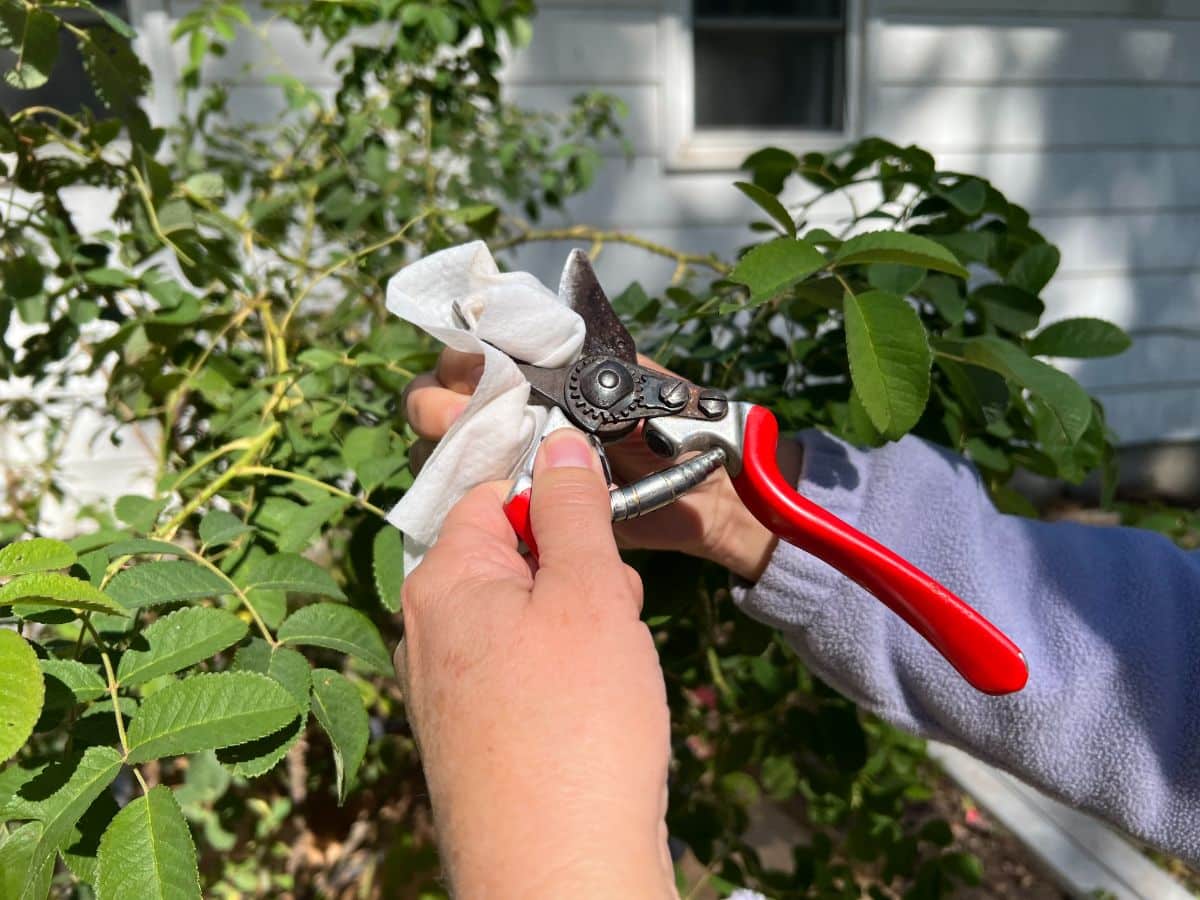
Diseases can be spread between roses by your pruners. Wipe them down with a cloth dipped in rubbing alcohol or a disinfectant wipe.
Water can spread diseases as well. If the rose is wet from rain or dew, your hands will pick up water droplets that contain spores or tiny insects and transfer them to other plants. Wait until the roses are dry to work with them.
4. Horticultural Oil Smothers Pest Eggs and Fungal Spores
On roses, horticultural oil is useful to kill insect pests and their eggs and stop disease spores from spreading on your roses and overwintering in the litter on the ground. It can be used through fall and winter to catch any diseases and pests you’ve missed while the leaves were still on the rose canes. Its residue doesn’t last long, making it eco-friendly.
5. Use Systemic Disease Granules to Stop Fungal Diseases
One year, I was falling behind on spraying in the rose garden. It kept raining on days that I needed to spray for blackspot, and I had a ton of chores on my plate. Finally, in desperation, I bought a tub of systemic granules and scratched them in around the roses.
Systemic granules are absorbed into the rose through the roots, so they protect the rose from within. I was pleasantly surprised to see the roses sprout new growth that was blackspot-free and it stayed clean. I was able to drop spraying off my endless list of things to do.
6. Build Up the Soil Around Your Roses for Increased Pest and Disease Resistance
It’s true that a plant is only as good as the soil it lives in. Giving a plant a healthy and balanced diet via the soil has a lot of health benefits for the plant, and with increased health comes better disease resistance.
Add compost to the soil, as well as organic fertilizers such as alfalfa meal, kelp meal, and other fertilizers made of organic material that’s slowly absorbed by the soil.
Organic mulch is also great, whether it’s wood chips, pine needles, a thick layer of chopped and shredded leaves, or anything else that protects the soil and slowly breaks down into black soil.
Diseases to Look Out For in The Fall Rose Garden
Blackspot
Every rose grower’s favorite disease!
Blackspot, caused by the fungus Diplocarpon rosae, is a fan of high humidity and rainy conditions. The spores of this common rose disease are splashed up onto the leaves from rain or sprinklers. If the spores stay wet for several hours on the leaf, then it will germinate and start infecting the leaf.
The small black spots start appearing within three days of being infected, and these spots can start releasing spores in 10 days after germination. This fungus moves fast! It does not mess around!
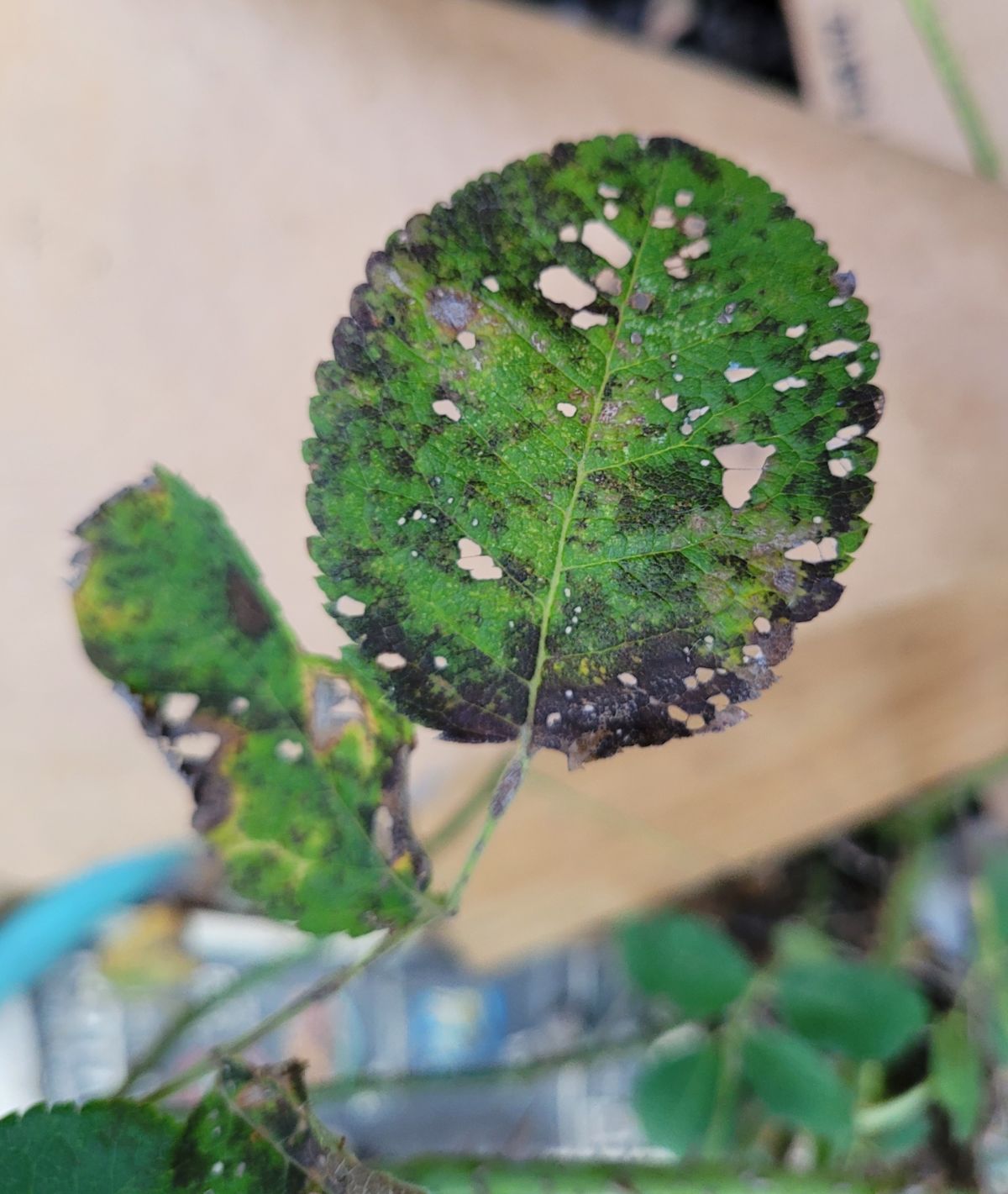
Blackspot will viciously attack hybrid teas and often causes all their leaves to fall off. (This is why one of my friends calls hybrid teas “blackspot on a stick.”)
Blackspot Control: If you’re planting new roses, choose varieties that are resistant to blackspot. I have a damask rose and a ‘Penelope’ rose that I have searched for blackspot to get a picture of, and the above was the only decent one I could get. Blackspot has not been a problem with these two.
When you have leaves with blackspot damage, pick them off and discard them outside the garden. Rake up blackspot leaves so they can’t reinfect your roses. Add mulch. Add systemic granular fungicide under the mulch and water it into your roses for protection against blackspot and powdery mildew (another common fungal disease that targets roses).
Keep water off leaves as much as possible so blackspot can’t get started on them. You can spray them with water on a hot, sunny day so the water quickly evaporates off, but otherwise, water from below, using a drip line or a soaker hose.
Rose Rosette Disease
Rose rosette disease, or RRD, is a virus that will kill your roses – and there is no cure.
Rose rosette is spread by windborne mites that are the size of dust. These infected mites are carried aloft by the wind, drifting around until they find a host rose and make themselves at home in the soft, green shoots.
When the mites start feeding on the rose, the rose rosette virus is injected into the plant, and now your rose is infected.
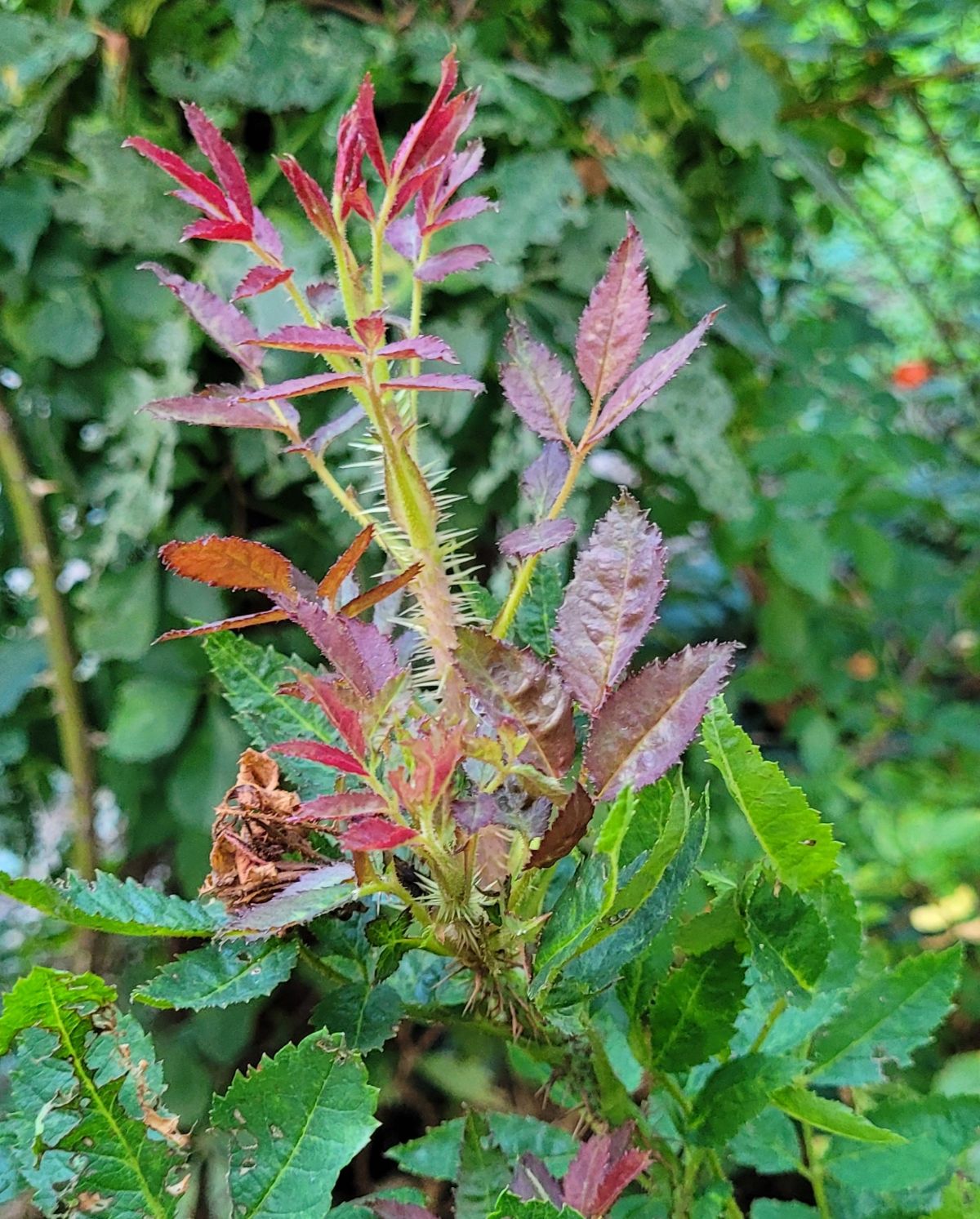
At this point, your rose will start growing strange-looking shoots that look nothing like the rest of your rose bush. You’ll see elongated, hyperthorny shoots, witches' brooms of deformed burgundy shoots, and weird rubbery canes.
One of the hallmarks of rose rosette disease is the fact that your rose is suddenly putting out weird, deformed growth that you’ve never seen before.
I have a personal vendetta against this disease.
In the late 1990s, when I was a newly minted municipal horticulturist, I discovered that the public rose garden that I was in charge of was filled to the brim with roses that were badly infected with rose rosette virus. Many were dying.
At the time, little was known about the disease. Eventually, through trial and error and a lot of research, I eventually learned how to contain it.
Here is what I did.
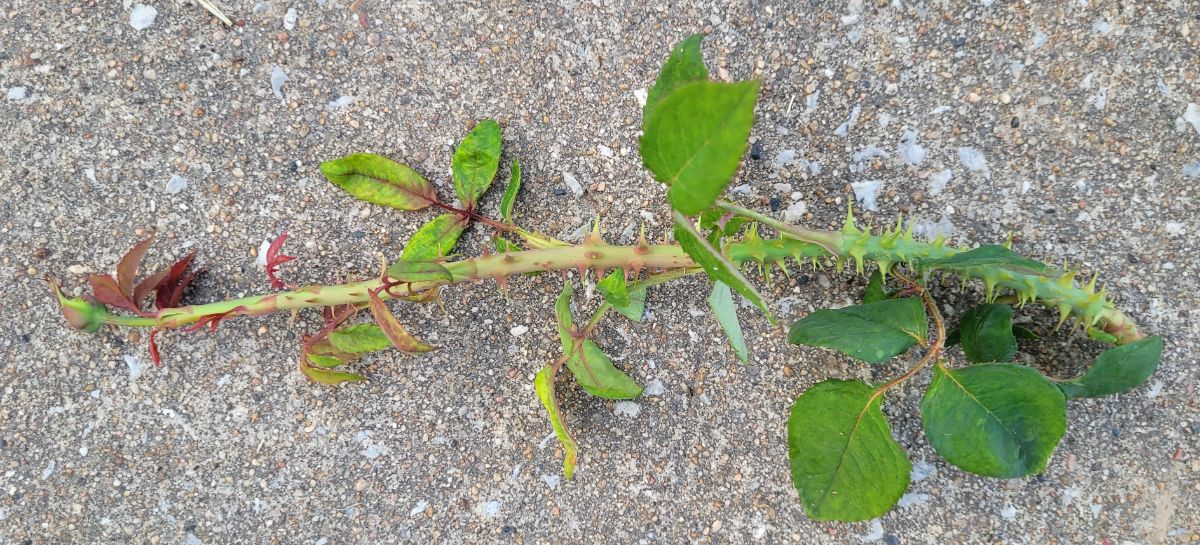
Rose Rosette Control: If you notice a brand-new sprig of rose rosette, or something that looks suspiciously like it, growing on your rose, act immediately.
Get a plastic or paper bag and put it over the infected shoot. Grip the bag to hold it shut below the RRD-infected area – and cut it off the rose about six inches below. Tie or knot the bag shut and immediately get it out of the garden.
Then sterilize your clippers or pruners with a 9:1 water to bleach solution, or spray them with rubbing alcohol, rubbing them well to scrub off any viruses. You can also use disinfectant wipes to clean them.
Boom. If you took off the growth quickly enough, your rose should be okay – but watch it like a hawk for any evil new infected growth.
If none comes back, good. If more growth appears, cut off the whole cane.
Generally, if you can stop the growth quickly, the virus won’t spread through the rose. However, once it reaches the bud union and it starts sprouting infected canes, dig up the whole rose and get it out of your garden.
Vigilance is key. Keep a close eye on all your roses.
Rose Mosaic Virus
Rose mosaic is actually caused by a group of viruses from two different genuses, Ilarvirus and Nepovirus, that have infected the rose. Rose mosaic is often a mix of Prunus necrotic ringspot virus, apple mosaic virus, arabis mosaic virus, strawberry latent ringspot, and tobacco ringspot virus.
In non-scientific terms, what you have here is basically a gang of viruses that roam around, beating up plants.
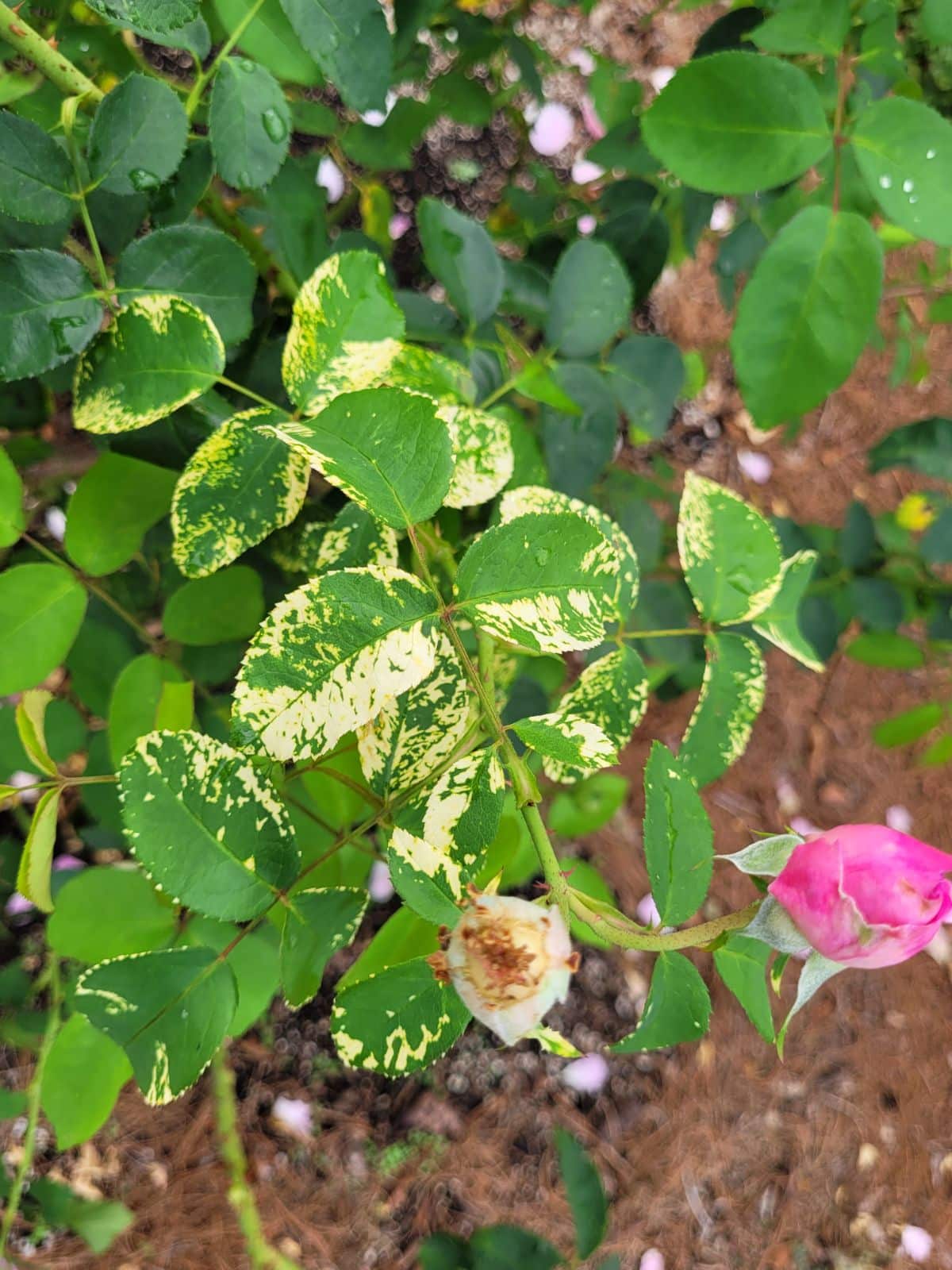
Due to the wide variety of different mosaic diseases in this complex, there’s no real “one size fits all” look for rose mosaic. Some mottling is very bright and noticeable, like in the photograph above. Some are subtle.
In mosaic-infected roses, however, you’ll usually see yellow stippling, lines, or spots on the leaves. Sometimes, leaves are slightly wavy or deformed. The rosebush seems to be otherwise healthy except for that particular patch. However, as the viruses spread through the rose, and as it puts out more odd, yellow-splotched leaves, the plant will weaken.
Mosaic is a virus, so there’s no easy cure. The diseased portion of the plant can be removed, but if the rest of the virus has been spreading through the plant, the symptoms might pop up elsewhere on your rose.
Rose Mosaic Prevention – Mosaic allegedly doesn’t spread from plant to plant, but it’s still a good idea to sanitize your pruners and clippers as you move from plant to plant. Mosaic-infected plants can spread the disease by grafting their roots with those of other nearby rosebushes, so keep them separated. Remove a virus-infected plant if it isn’t growing as well and plant its replacement elsewhere. Perhaps plant a cheerful perennial or shrub that is NOT a member of the rose family in that spot instead.
One important and helpful factor: If you smoke, don’t put your cigarette butts in the compost or soil. The tobacco can contain tobacco mosaic disease, which can spread to roses, tomatoes, or other plants. The little flame in your cigarette is not hot enough to destroy the mosaic virus, and not even the hottest compost heap will hurt it – unless your compost heats up to over 1000 degrees Celsius!
Spider Mites
Hot and dry weather can lead to a spider mite infestation. Spider mites will infect some roses (I had an antique rose called ‘Rose de Rescht’ that kept catching them), as well as other plants such as burning bushes and marigolds.

Rose bushes infested with spider mites generally turn brownish-red, the leaves looking as if the sun burned them. Sometimes, infected leaves are speckled thickly with yellow. When you turn the leaf over, you may see little webs and some tiny salt-and-pepper grit.
Spider mites will spin tiny webs (hence their name) and are notoriously hard to get rid of because they like to hide out under the leaves and in places where sprays can’t get to them.
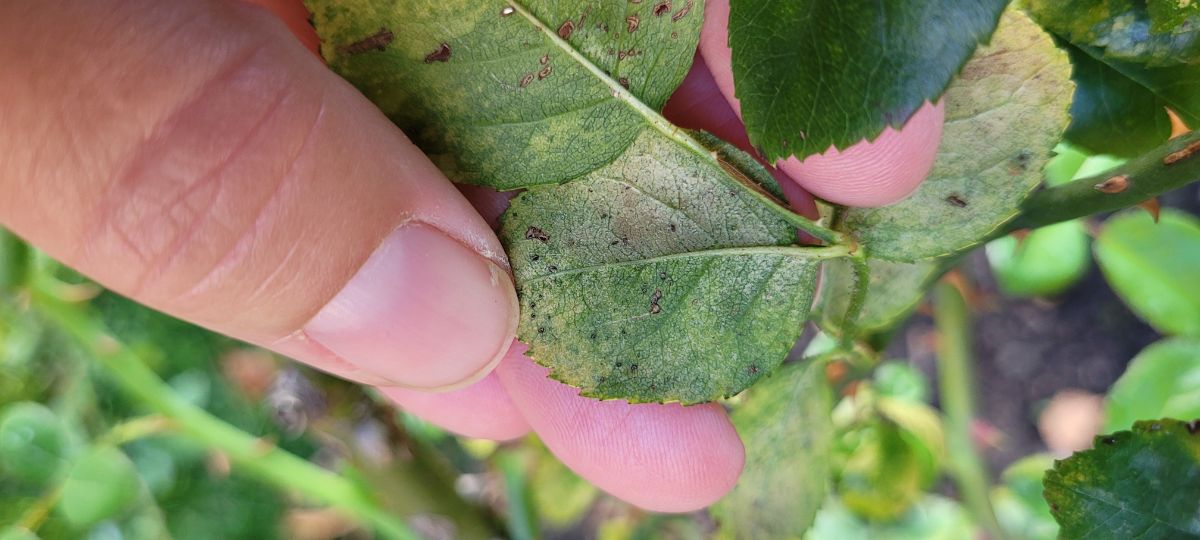
Spider Mite Control: Spider mites hate cool and moist conditions. Grab the garden hose, turn it on full blast, and spray infected leaves from underneath. This disrupts their activity and washes off the dust that hides the mites from natural predators.
Once your rose has dried off, spray horticultural oil or dormant oil on the affected area. This suffocates the mites with a thin layer of oil that still allows the plants to breathe. It's also a safe way to kill the mites. Be sure to spray horticultural oil on cool days to try and keep the leaves from burning.
Repeat this rigamarole a few times. Also, pick off leaves that are infested with spider mites and dispose of them away from the garden.
Botrytis
When you have a lot of wet and cold weather, keep an eye on your rose blossoms. This damp weather can start an outbreak of botrytis blight in your roses.
This is a blight caused by a fungus called Botrytis cinerea, also known as grey mold. This rose disease loves high humidity, lots of rainfall, temperatures that hover around 60 degrees F (15 degrees C), and no air circulation.
Botrytis shows up as small pink dots on your rose petals. If there’s no break in the cool, wet weather, botrytis starts to spread and soon turns the blossoms into brown, soggy mush. Rose petals become matted and stick together. Botrytis-infected rose blossoms can’t open, and so they “ball up,” while other roses turn into a shattered mess of brown petals.
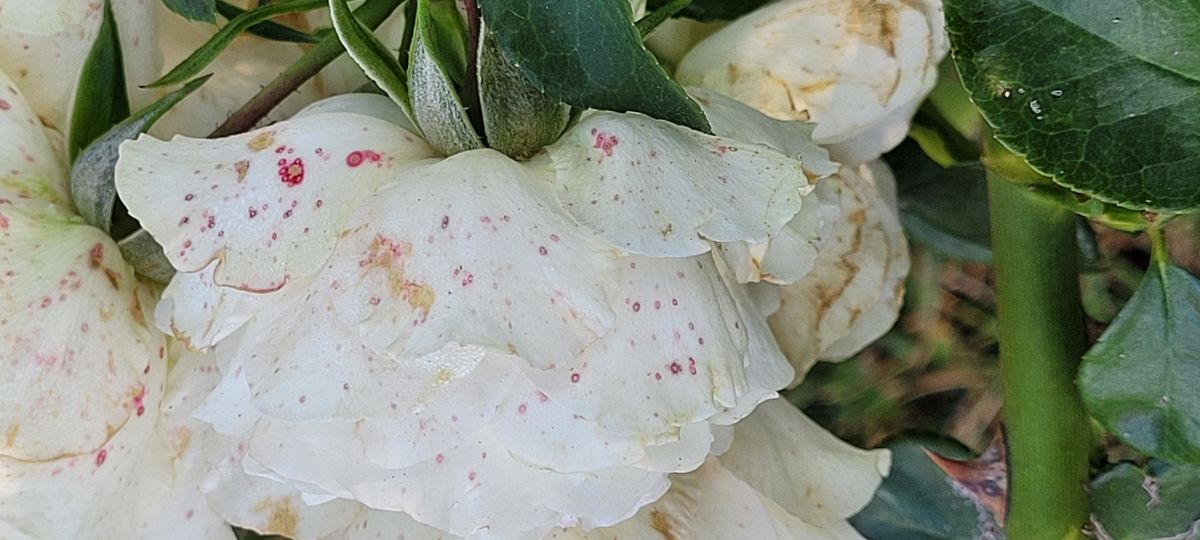
This blight can also affect rose twigs and bare-root roses, turning parts of the cane brown. When the stem lesions completely circle the cane, the rose will wilt and die above that point.
Affected blossoms and canes will then sprout wooly grey fungus as the botrytis starts spreading spores to your other roses, as well as your grapes, dahlias, tulips, and marigolds.
Hot, dry weather will put a stop to this blight. However, botrytis spores will lie in wait for the next period of cold, wet weather to unleash its fury on your roses once again!
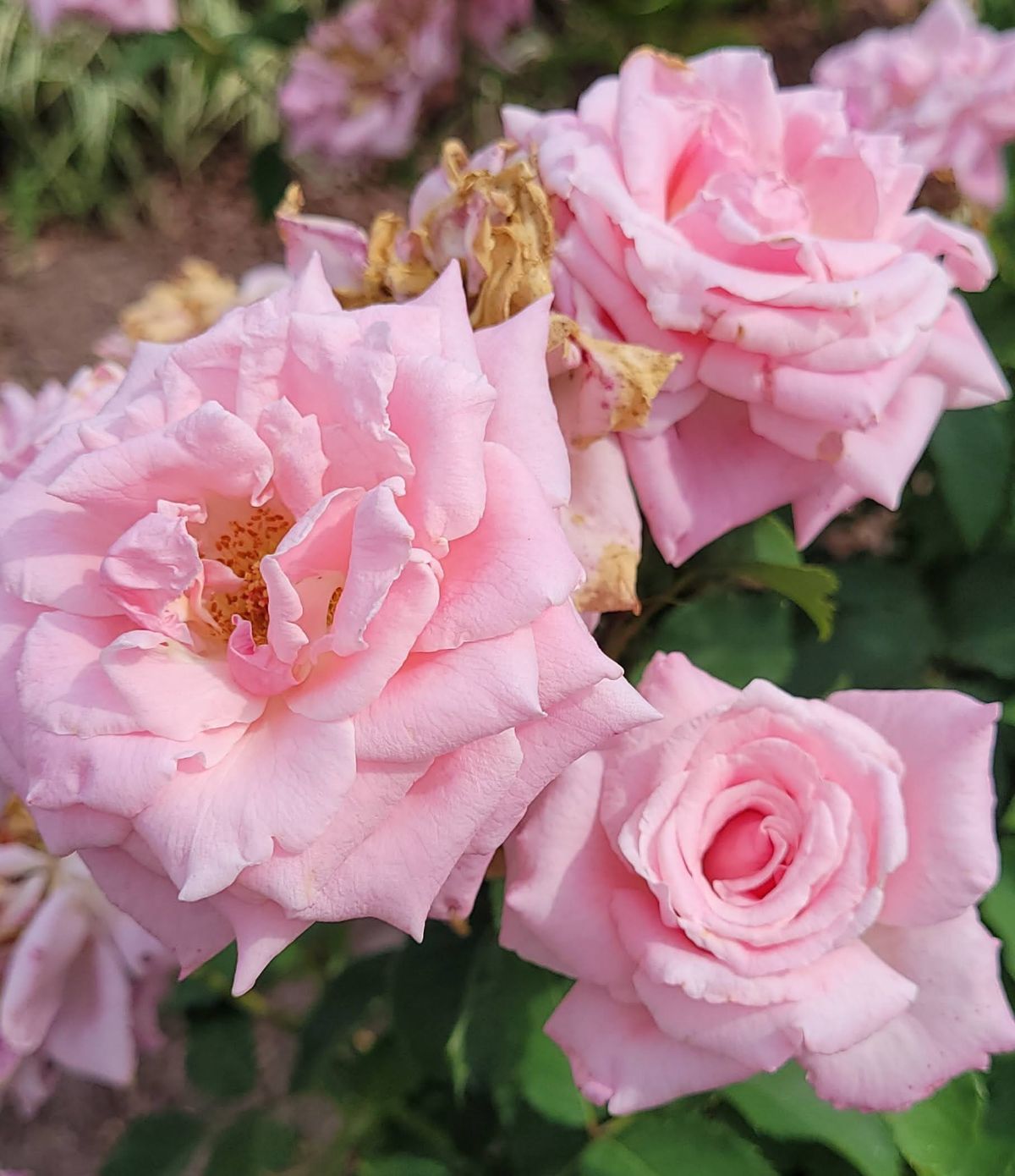
Botrytis Blight Control: You can limit botrytis in your rose garden. Remove infected blossoms when you notice them, as well as any stems with lesions on them or those that are completely dying back. Get rid of fallen rose leaves and petals by bagging them and disposing of them away from the roses. Don’t compost them.
Avoid wetting foliage. Drip lines or soaker hoses are more effective (and cost-effective as well) in watering your roses. Improve air circulation around your roses by removing plants, spacing them out, and cutting back the lower canopy of a few nearby trees.
Horticultural oil can help control botrytis. However, don’t use horticultural oil within three weeks of using a sulfur spray. This can adversely affect leaves. Water your roses well the day before spraying horticultural oil. And never spray oil if temperatures are going to be over 90 degrees F (30 degrees C).
Rose Borers
Rose borers are a type of small, otherwise helpful wasp that prey on aphids.
These small wasps will find a cut end of a rose and lay an egg there. The larva hatches out and will burrow down into the soft pith of the rose. The female wasp brings its aphids to feed it for about two weeks until the larva metamorphoses into an adult wasp.
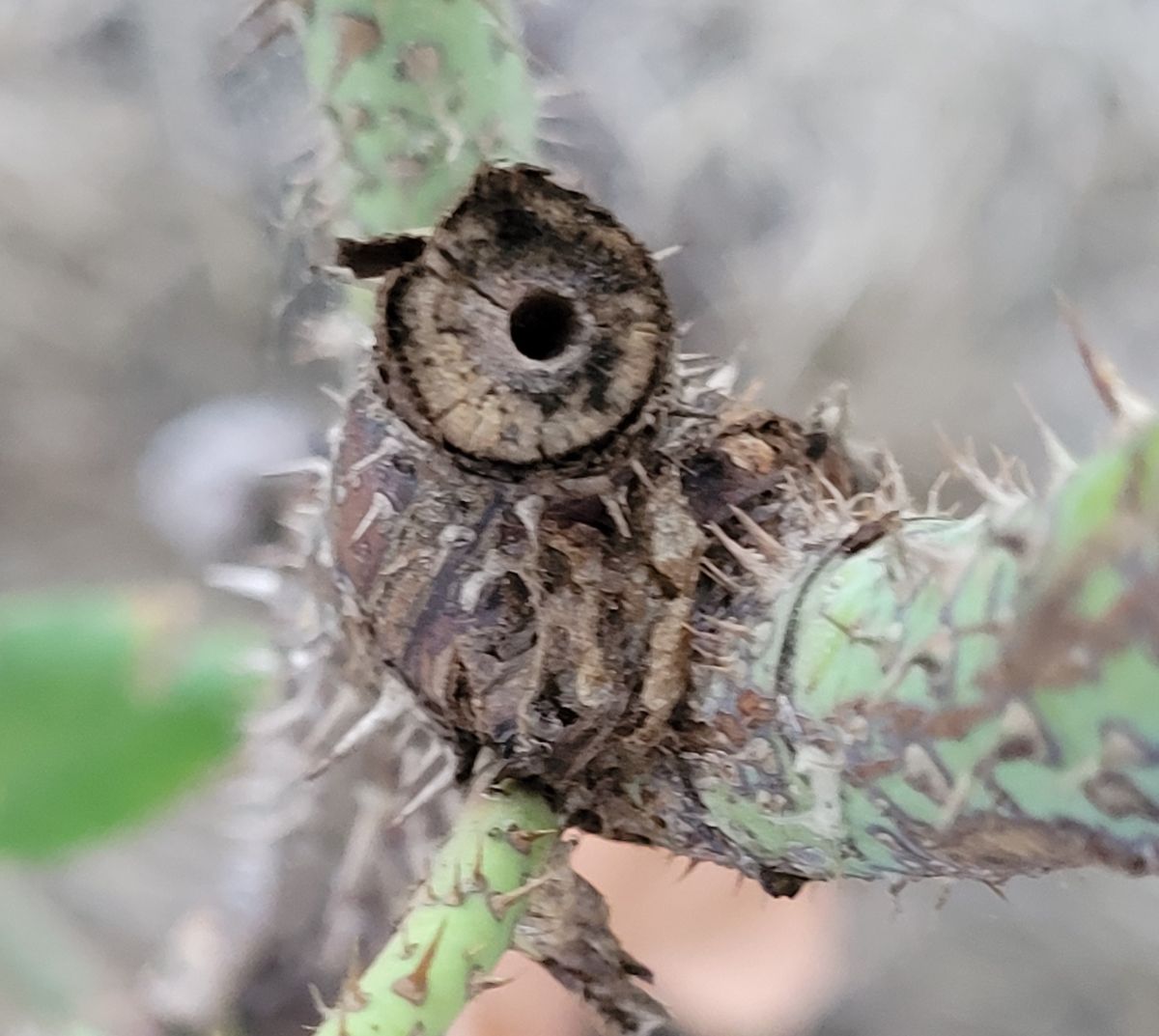
Cut off the cane that the borer has dug into, going clear down to where there’s no more tunnel. If it goes clear down to the base of the rose, it’s okay – getting rid of old rose canes is a good way to encourage basal breaks – these are where the new rose canes will grow from.
To encourage new canes to form, cut out any other old, gray canes and clear down to the bud union. Also, give the rose some alfalfa fertilizer next spring.
Rose Borer Prevention: Every time you cut off a rose cane, cover the wound with a coat of glue or clear nail polish. This will keep rose borer larvae out of the pith.
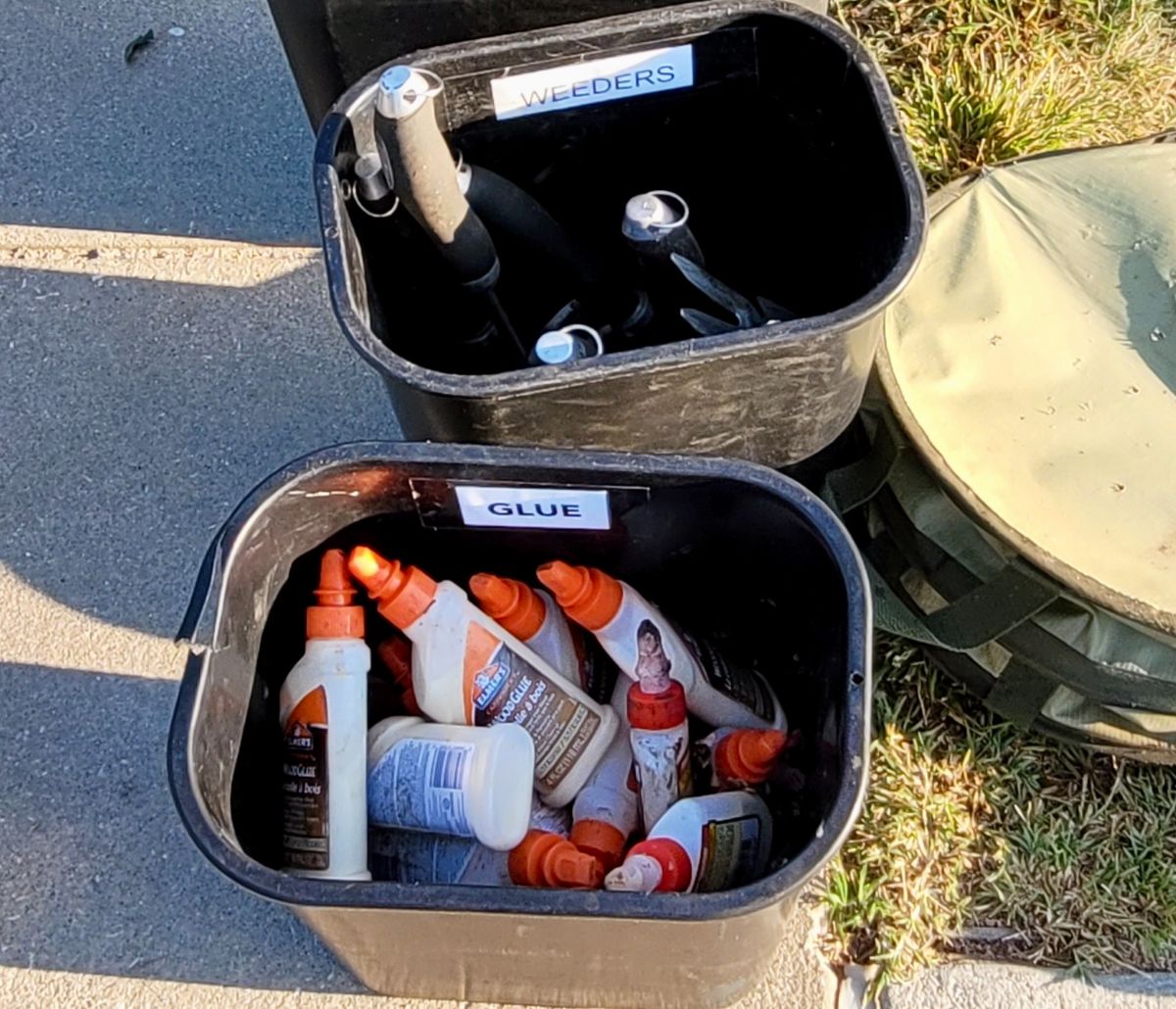
I don’t recommend any other kinds of control against these wasps since they’re effective aphid killers. Just use a dab of glue to seal them out and call it good!

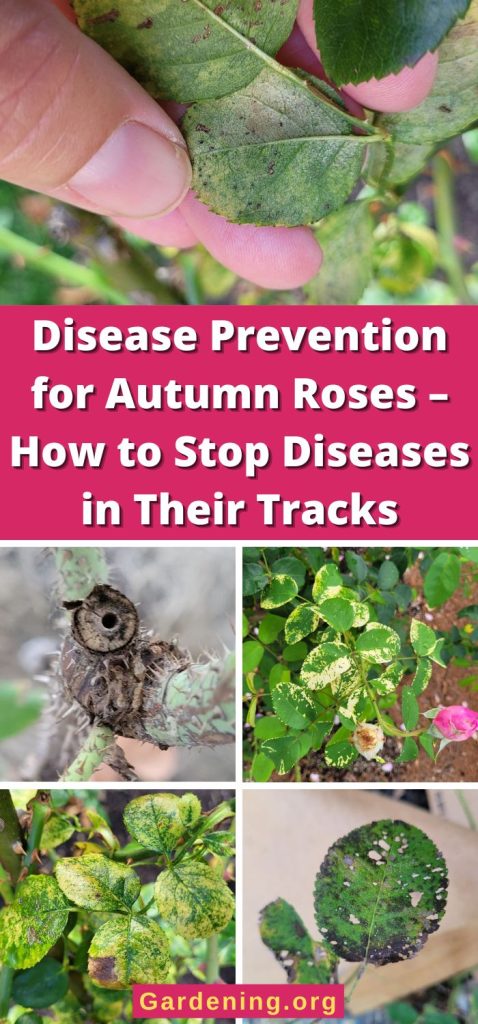
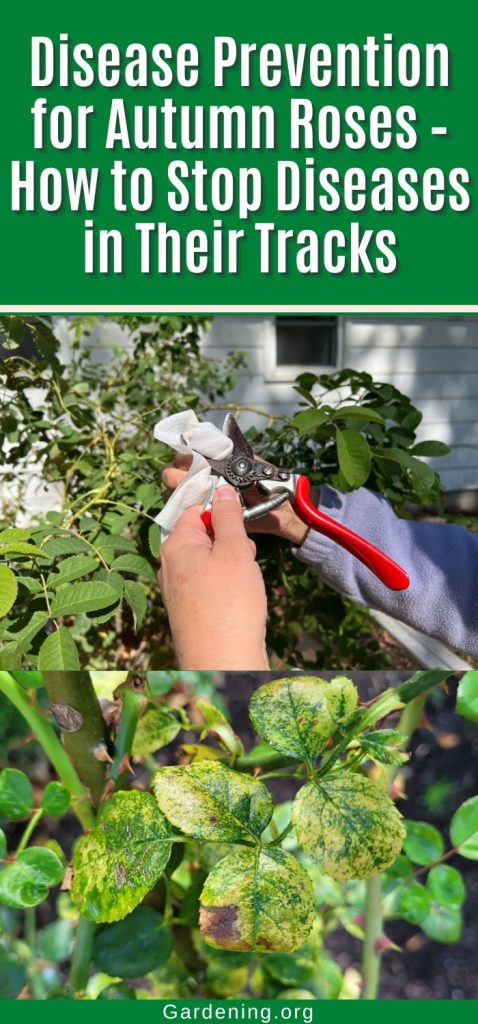
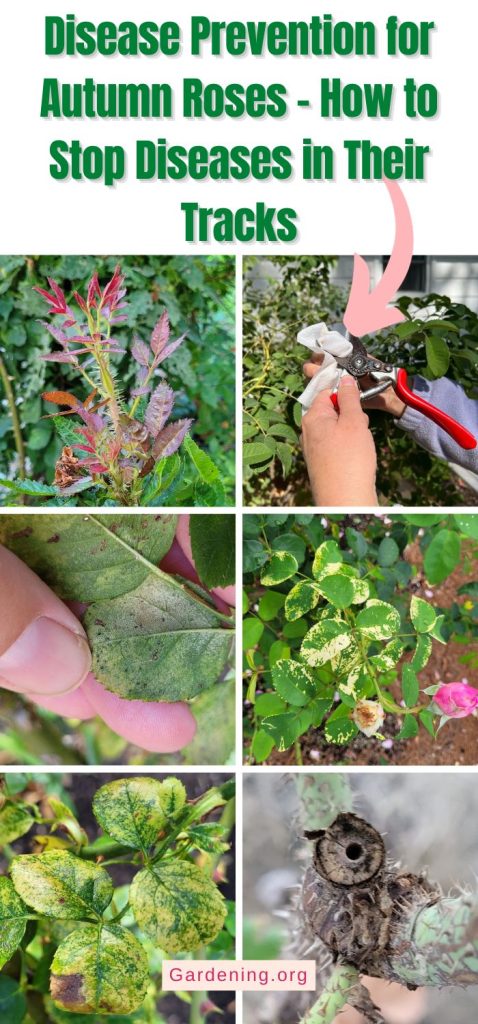
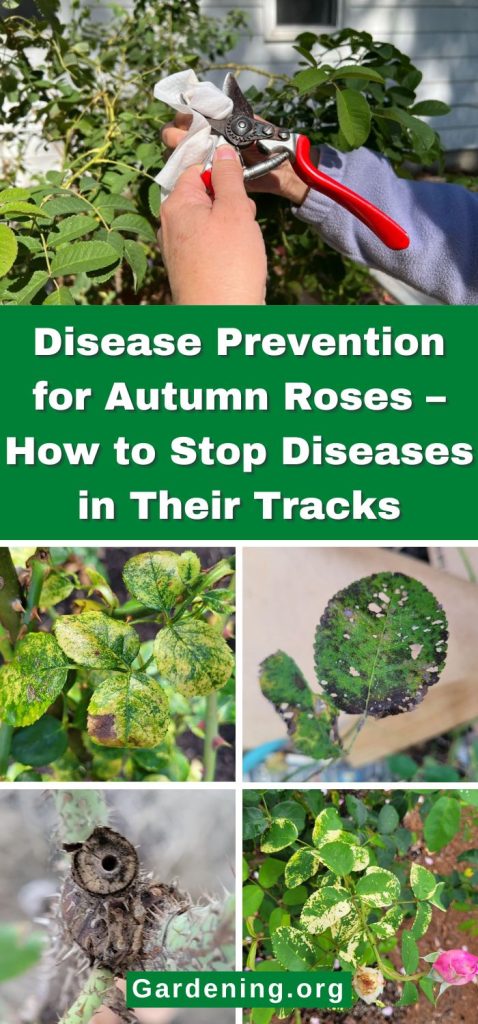




Leave a Reply